UP Board Notes For Class 10 Science Chapter 12 Endocrine System And Adolescence Learning objectives
After completing this chapter, you will be able to:
- Discuss the role of endocrine system in maintaining homeostasis;ZZ
- Define the term hormone;
- Describe the location of the major endocrine glands in the human body,
- List the major hormones secreted by the following endocrine glands and discuss their functions:
- Adrenal gland
- pancreas
- Thyroid gland
- pituitary glan
- Explain the effects of hyposecretion and hypersecretion of major hormones on the body;
- Describe the mechanism of hormonal action and regulation or the feedback mechanism.
- All organs, tissues, and cells in our body work in coordination. There are two regulatory systems involved in control and coordination of our body, namely, nervous system and endocrine system.
- In the previous chapters, you have read about nervous system and the functions performed by it. There is one more system involved in coordinating

various body activities. This is known as the endocrine system. The endocrine system affects body activities by releasing chemical messengers, called hormones, into the bloodstream. The endocrine system consists of many glands; however, in this chapter, we will learn about adrenal, pancreas, thyroid, and pituitary glands only.
UP Board Notes For Class 10 Science Chapter 12 Endocrine System And Adolescence Adjusting To Changes – Homeostasis
- The activities in our body occur in a coordinated manner and have to be regulated at a proper time. If any step in the coordination misses out, then our body is severely affected.
- Let us consider an example to understand this. We tend to sweat a lot on a hot day. Evaporation of the sweat cools down our body and helps to cope with the heat. We feel thirsty and drink more fluids on a hot day. Thus, our internal system adjusts itself to cope with the external stress and attempts to maintain a steady state of functioning.
| Class 10 Science | Class 11 Chemistry |
| Class 11 Chemistry | Transformation of Sentences |
| Class 8 Maths | Class 8 Science |
The capacity of an organism to adjust itself to cope with the external changes and maintain a steady state of functioning is called homeostasis.
In our body, homeostasis is achieved by both the nervous and the endocrine systems, but in different ways, as given in
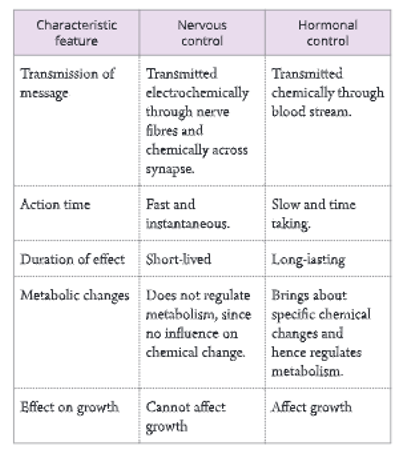
UP Board Notes For Class 10 Science Chapter 12 Endocrine System And Adolescence What Are Hormones?
Hormones:
- Hormone means to set in motion or to spur on. Hormones are chemical secretions secreted by specific endocrine glands, which are carried by blood to the target organs elsewhere in the body to stimulate a specific activity. Thus, hormones are special chemicals that regulate the physiological or biochemical processes in our body.
Bayliss and Starling, two British scientists, coined the term hormone in 1905 while working on hormonal secretions.
Characteristics of Hormones
- Hormones are regulatory chemicals that are secreted by endocrine glands directly into the blood.
- Some hormones are chemically made of proteins or polypeptides (e.g. insulin) which are water soluble;
Endocrine and Exocrine Glands
Hormones are secreted by endocrine glands (Gk. endo: within or inside; crin: secretion). These are also called ductless glands because they do not have their own ducts, and their secretions are directly released into the tissue space next to them from where these are carried by the blood to the target organ. On the other hand, an exocrine gland secretes material directly into the duct. They have their own ducts which carry the secretions directly to the target organs.
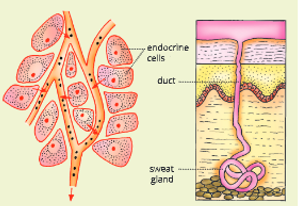
a. An endocrine gland secretes hormones into the extracellular fluld.
b. An exocrine gland secretes material into a duct.
some are amines (e.g. adrenaline and noradrenaline) which are also water-soluble, and some are steroids which are derived from cholesterol, and other steroids (e.g. testosterone and progesterone) which are lipid-soluble.
- Hormones are produced in very minute quantities.
- They are biologically very active but are slower than nervous control.
- They act only on target organs or cells located away from their sources. Thus, they are produced by one organ but act on some other organ.
- They regulate the physiological process of the body by bringing about chemical changes. Thus, they bring about metabolic regulation in the body.
- They are destroyed soon after their action, and thus, they are not stored in the body.
- Steroid hormones They are steroids In nature. They diffuse through the cell membrane and bind to Internal receptors. Examples: Oestrogen, progesterone, androgens, cortisol, aldosterone, thyroid hormones, etc.
- Peptide or non-steroidal hormones These are amino acid derivatives, peptides, or proteins. They bind to receptors located on the surface of target cell. Examples: Glucagons, ADH, oxytocin, Insulin, somatotropin, prolactin, FSH, LH, TSH, etc.
UP Board Notes For Class 10 Science Chapter 12 Endocrine System And Adolescence Endocrine Glands
Major endocrine glands in our body are as follows:
1. Adrenal glands
2. Thyroid gland
3. Pancreas (pancreatic islets clusters)
4. Pituitary gland (anterior and posterior)
5. Parathyroid glands (four in humans)
6. Thymus gland
7. Pineal gland
8. Gonads
In addition, endocrine cells of stomach, duodenum, liver, kidney, placenta, etc. also secrete hormones.
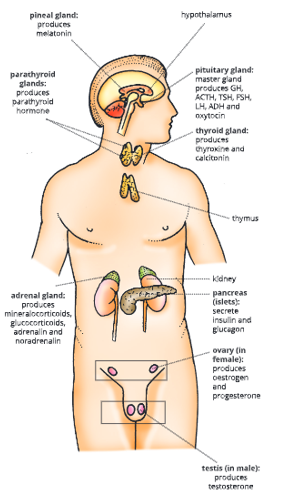
In this chapter, we will study about thyroid, adrenal, pancreas, and pituitary glands only. Location of various endocrine glands and their secretions are given in
UP Board Notes For Class 10 Science Chapter 12 Endocrine System And Adolescence Adrenal Glands
In our body, two adrenal glands are present, one on top of each kidney; hence, they are also called suprarenal glands. Each adrenal gland has following two parts:
1. Adrenal cortex (on the outer periphery)
2. Adrenal medulla (inside central part)
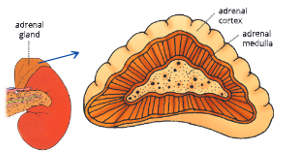
a. Kidney
b.Cross section of adrenal gland
UP Board Notes For Class 10 Science Chapter 12 Endocrine System And Adolescence Adrenal cortex
Adrenal cortex secretes two main hormones – glucocorticoids and mineralocorticoids.
Endocrine System Glucocorticoids
Glucocorticoids are group of hormones such as cortisol, corticosterone, and cortisone. Of the three, cortisol is the major hormone. Glucocorticoids,
- Regulate the metabolism of proteins, fats (lipids), and carbohydrates in the body;
- Regulate the blood sugar level and ensure energy supply to the body;
- Adapt the body to external stress such as severe heat or cold, infections and burns, etc.
Apart from these, certain cortical hormones act as sex hormones causing premature sexual maturity in children.
- Hyposecretion of glucocorticoids causes Addison’s disease. person suffers from mental lethargy, nausea and vomiting, weight loss, and muscular weakness. Hypersecretion of glucocorticoids causes Cushing’s syndrome. In this condition, person becomes obese, has high blood sugar levels, osteoporosis, weakness, and salt and water retention.
Mineralocorticoids (Aldosterone)
Aldosterone is a major mineralocorticoid secreted by adrenal cortex. Aldosterone,
- Controls mineral metabolism by reabsorption of sodium in urinary tubules and maintains Na* and K* ratio in the extracellular and intracellular fluids;
- Regulates salt-water balance in the body.
Hypersecretion of aldosterone causes increased sodium and decreased potassium concentration in the blood, leading to hypertension (high blood pressure).
UP Board Notes For Class 10 Science Chapter 12 Endocrine System And Adolescence Adrenal Medulla
- Adrenal medulla secretes two major hormones – adrenalin (also known as epinephrine) and nor-adrenalin (norepinephrine). Adrenalin accounts for almost 80 percent of the total secretion of the adrenal medulla.
- Both adrenalin and noradrenalin together control emotions, fear, anger, blood pressure, heartbeat, respiration, and relaxation of smooth muscles. Adrenalin is also known as an emergency hormone as it prepares the body for fight-or-flight situations.
- Adrenalin increases heartbeat and blood supply to muscles and decreases blood supply to visceral organs. We have high levels of adrenalin while playing or running. Effect of adrenalin on some organs of our body is given in
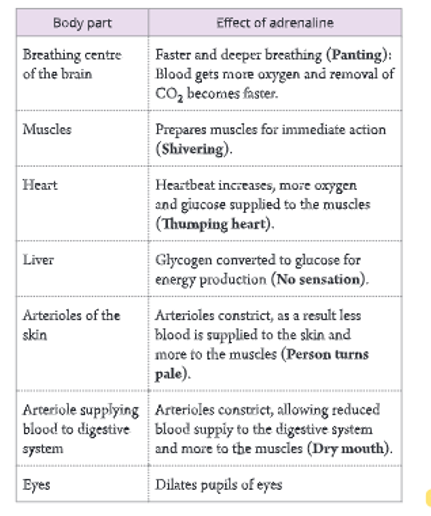
UP Board Notes For Class 10 Science Chapter 12 Endocrine System And Adolescence Thyroid Gland
The thyroid gland is a large endocrine gland located in front of the neck region just below the larynx. It has two lateral lobes, one on either side of the trachea. The two lobes are connected by a narrow mass of tissue called isthmus. The thyroid gland has a rich blood supply. Thus, thyroid gland can deliver large amounts of hormones in a short period of time, if necessary. Four small round parathyroid glands are embedded in the posterior surface of the thyroid gland.
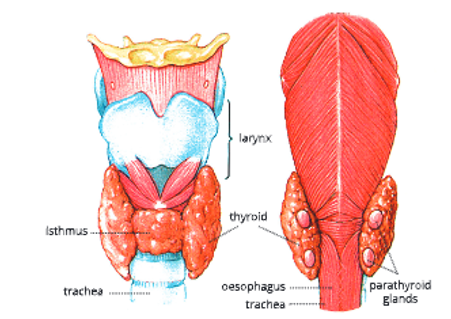
a. Anterior suface
b. posterior surface
The thyroid gland secretes two hormones thyroxine and calcitonin.
a. Thyroxine
- It regulates basal metabolism by stimulating rate of cellular oxidation, resulting in energy production and maintenance of body temperature.
- It regulates general growth of the body, ossification of bones, and mental development.
- It regulates activities of the nervous system. Undersecretion (hyposecretion) as well as
oversecretion (hypersecretion) of thyroxine result in an abnormal growth of the body.
Undersecretion of thyroxine (Hypothyroidism)
Undersecretion of thyroxine may cause,
1. Simple goiter: In this condition, the thyroid. gland of adults enlarges and becomes visible as a swelling in the neck. Undersecretion of thyroxine or insufficient amount of iodine in diet may cause simple goiter.
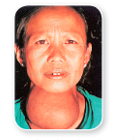
Simple goiter is common in people living in hilly areas because the soil of hilly areas is deficient in iodine. Thus, the food crops grown there have less iodine content.
2. Cretinism (in children): This is caused due to defective development or early atrophy
(degeneration) of thyroid gland. This condition is observed in children. Children suffering from cretinism have stunted growth (dwarfism), short club-like fingers, and deformed bones and teeth. Their abdomen becomes pot-bellied, and skin becomes rough, dry with scanty hair growth. Mental retardation f various degrees is also observed.
3. Myxoedema (in adults): The hypothyroidism in adults causes myxoedema. In this condition, facial tissues swell and look puffy. Other symptoms include slow heart rate, low body temperature, sensitivity to cold, dry hair and skin, muscular weakness and general lethargy.
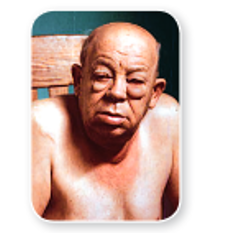
Oversecretion of thyroxine (hyperthyroidism)
Oversecretion of thyroxine may cause exophthalmic goitre. A person suffering from this disorder shows increased metabolic rate, rapid heartbeat, protruding eyes and short breathing rate.
b. Calcitonin (Not included in the syllabus)
Calcitonin is another hormone secreted by thyroid gland.
- It regulates calcium and phosphate levels in the blood.
- It facilitates absorption of calcium released by bones.
UP Board Notes For Class 10 Science Chapter 12 Endocrine System And Adolescence Endocrine System Pancreas
Pancreas is a compound gland located posterior to the stomach and attached to the duodenal loop in the abdominal region. It secretes both enzymes (digestive juices) as well as hormones. It has two parts –
1. An exocrine (duct) part, which produces digestive juices, and
2. An endocrine (ductless) part, which secretes hormones.
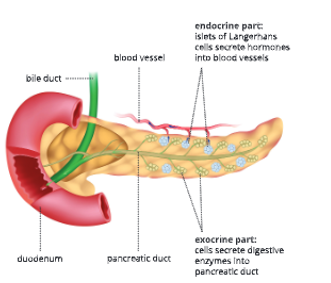
Its endocrine part contains hormone-secreting cells called islets of Langerhans, which are scattered in the entire gland (islets: little islands). The islets of Langerhans in pancreas contain alpha, beta and delta cells that secrete glucagon, insulin and somatostatin hormones, respectively.
Insulin
Insulin is secreted by beta cells of islets of Langerhans.
- It regulates blood sugar level by regulating conversion of glucose into glycogen. Whenever there is an increase in blood glucose, insulin is secreted which induces absorption of glucose through cells. This glucose is burnt or stored as glycogen. This reduces the blood glucose level.
- It stimulates deposition of extra glucose as glycogen in the liver and muscles.
- Undersecretion (hyposecretion) of insulin causes diabetes mellitus or hyperglycemia. A person suffering from diabetes mellitus has high concentration of glucose in the blood and urine. The sufferer feels thirsty because of loss of water through excessive urination and becomes weak.
- Oversecretion (hypersecretion) of insulin causes insulin shock or hypoglycemia. In this condition, sugar level in bloodis severely reduced and in adverse condition brain may enter into a state of coma. The person may also becom onscious at frequent intervals.
Why is Insulin Injected and Not Taken Orally?
When required, insulin is injected into the body, and not taken orally because if taken orally, it will be digested by the protein-digesting enzymes in the digestive tract.
Glucagon
Glucagon is secreted by alpha cells of islets of Langerhans.
- It stimulates glycogen breakdown in the liver and converts some carbohydrates back to glucose.
- It increases sugar level in the blood.
UP Board Notes For Class 10 Science Chapter 12 Endocrine System And Adolescence Pituitary – the Master Gland
- The pituitary is a small gland about 1 cm in diameter (about size of a pea). It lies just below the hypothalamus (the midbrain) connected to it by a stalk-like structure called hypophyseal stalk.
- It is popularly known as master gland because it controls the functioning of all other endocrine glands. Since most hormones secreted by pituitary stimulate other glands to produce their hormones, they are called tropic hormones. Thus tropic
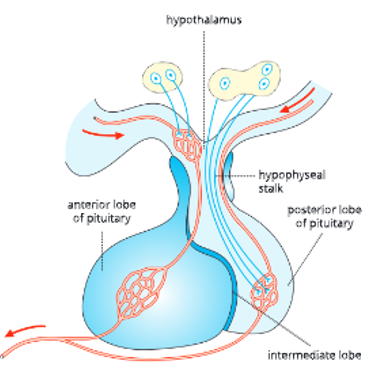
- hormones are those hormones that stimulate other endocrine glands to secrete their own specific hormones. For example, follicle-stimulating hormone (FSH) and luteinizing hormone (LH) are also called gonadotropic hormones because they regulate functioning of gonads (ovaries and testes) to produce sex hormones.
- Except for human growth hormone, melanocyte-stimulating hormone (MSH), and prolactin (PRL), all the other hormones are tropic hormones.
The pituitary is mainly divided into three lobes.
1. The anterior lobe
2. The posterior lobe
3. The intermediate lobe (almost absent in humans)
Hormones of the anterior pituitary
The anterior pituitary releases at least six different hormones some of which are as follows.
1. Growth hormone (GH) or somatotropic hormone (STH) or somatotropin
- It controls the overall development or growth of the body, muscles and bones.
- It also stimulates fat metabolism.
- It increases the rate of protein synthesis.
- Deficiency (hyposecretion) of GH in the childhood causes dwarfism. In this condition, the muscles and skeleton do not grow much and the body proportions are like a child’s.
- Oversecretion (hypersecretion) of GH in the childhood causes gigantism. In this condition, the child has very tall skeleton and proportionately large muscles The oversecretion of GH in an adult leads to overgrowth of the bones and jaw bone and bowing of the spine. This condition is called acromegaly.

a. Gigantism
b. Dwarfism
Thyroid-stimulating hormone (TSH)
- It controls the growth and functioning of the thyroid gland.
- It stimulates the thyroid gland to produce thyroxine.
Adrenocorticotropic hormone (ACTH)
- It regulates the activity of adrenal cortex.
Gonad stimulating (Gonadotropic) hormones
a. Follicle stimulating hormone (FSH)
- In males, it stimulates the process of spermatogenesis.
- In females, it stimulates the follicle cells in the ovaries to develop into mature eggs and also stimulates them to produce estrogen.
b. Luteinizing hormone (LH)
- In males, it stimulates the secretion of testosterone, which in turn influences the appearance of secondary sexual characteristics.
- In females, it stimulates the secretion of estrogen and progesterone, which in turn influence the process of ovulation, formation, and maintenance of corpus luteum and appearance of secondary sexual characteristics.
Tropic hormone
A hormone that stimulates other endocrine glands to produce/secrete their specific hormone.
Prolactin hormone (PRL)
- In females, it enhances mammary gland development and milk production.
- In males, it enhances the production of testosterone.
Hormones of the posterior pituitary
- The posterior pituitary stores two hormones, antidiuretic hormone (ADH) also called vasopressin, and oxytocin. Both these hormones are produced and released by hypothalamus (and not by the pituitary as given in most books). These hormones are transported to posterior pituitary and stored there.
Antidiuretic hormone (ADH) or vasopressin
- It promotes reabsorption of water from the kidney tubules. Thus, it causes the kidney to form more and more concentrated urine.
- It constricts blood vessels with the rise in blood pressure.
- The deficiency of ADH causes diabetes insipidus. In this disease, a person urinates more frequently and a large amount of urine is produced each time. This results in the loss of water from the body and the person feels thirsty. In diabetes insipidus, the urine does not contain any sugar.
Oxytocin
- It stimulates vigorous contraction of the uterus during labor, leading to the childbirth.
- It also causes the release of milk from the breast of a nursing mother.
Hormones of intermediate lobe of pituitary
It secretes melanocyte-stimulating hormone (MSH), that stimulates skin to secrete melanocytes (melanin pigment).
Summary of major hormones secreted in human body, their source glands and principal functions are given in Table
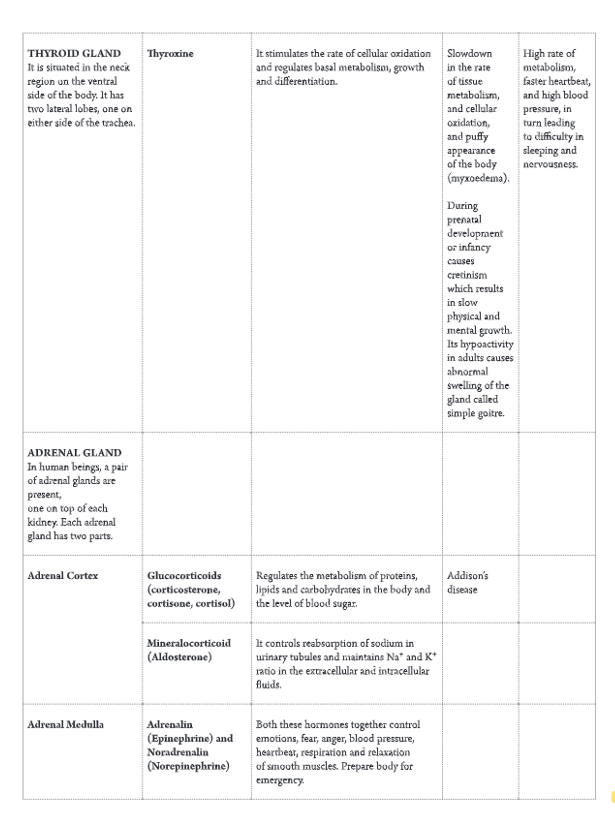
UP Board Notes For Class 10 Science Chapter 12 Endocrine System And Adolescence Feedback Mechanism Of Hormone Secretion
As we know, hormones are required for various functions in our body. To perform these functions, a
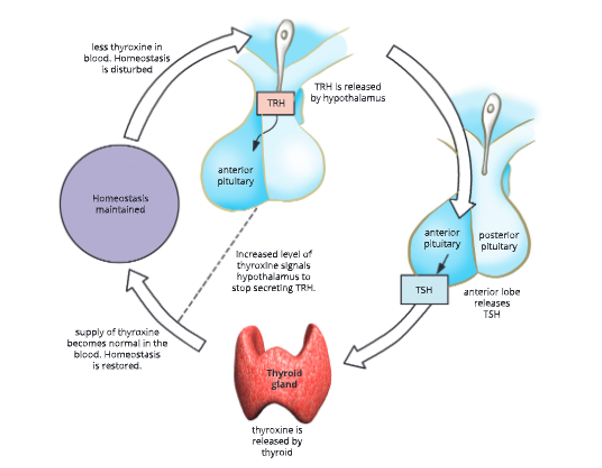
- particular hormone may be required in a particular amount at a particular time, for which a control system is required. A control system should have a feedback mechanism to prevent excessive reaction or over-reaction. For example, the hypothalamus produces thyrotropin-releasing hormone (TRH), which in turn stimulates the anterior pituitary to produce thyroid-stimulating hormone (TSH). The TSH activates the thyroid gland to
- secrete thyroxine. If the level of thyroxine in the blood is less than normal, it has a positive feedback effect on the hypothalamus and pituitary to produce more TRH and TSH, respectively. If the level of thyroxine is more than normal in the blood, a negative feedback effect is seen on the hypothalamus and the pituitary so that they produce less of TRH and TSH, respectively. Positive feedback systems are relatively rare in higher vertebrates as they lead to instability.
- Thyroid-stimulating hormone (TSH) and thyroxine regulate each other’s level just like the requirement-supply kind of situation. Such a system of opposing effects leads to proper control and balance in a system. The two opposing systems work in coordination and help the body to adjust its output accordingly. The ultimate. effect of such a feedback system is to maintain homeostasis.
UP Board Notes For Class 10 Science Chapter 12 Endocrine System And Adolescence Summary
- Hormones are chemical messengers secreted by endocrine glands and carried by blood or lymph to a target organ elsewhere in the body to stimulate a specific physiological change.
- Hormones (1) are secreted in minute quantity, (2) are specific chemical messengers, (3) regulate physiological processes by chemical means, (4) are secreted by ductless (endocrine) glands, (5) are poured directly into the bloodstream, and (6) their action is very rapid and they act on a specific target, away from the source.
- Adrenal glands are also called suprarenal glands. Each
- adrenal gland has an outer region called cortex and an inner region called medulla.
- Adrenal cortex secretes glucocorticoids and mineralocorticoids.
- Glucocorticoids regulate metabolism of proteins, fats and carbohydrates in the body and regulate blood
- pressure and heartbeat rate and are called emergency hormones.
- Mineralocorticoids (aldosterone) control reabsorption of sodium in kidney tubules.
- Adrenal medulla secretes adrenalin and noradrenalin hormones. Both these hormones together control emotions, fear, anger, blood
- Thyroid gland is situated in the neck region. It secretes two hormones – thyroxine and calcitonin.
- Thyroxine stimulates rate of cellular oxidation and basal metabolism.
- Calcitonin regulates calcium and phosphate levels in the blood.
- Pancreas produces Insulin from beta cells and glucagon from alpha cells of islets of Langerhans.
- Insulin regulates conversion of glucose to glycogen.
- Hyposecretion of insulin causes diabetes mellitus.
- Glucagon regulates the conversion of glycogen and some non-carbohydrates back to glucose.
- Pituitary gland has three lobes – anterior lobe, posterior lobe, and intermediate lobe.
- Anterior pituitary secretes six main hormones –
- Growth hormone (GH) controls the overall growth of the body. Its hyposecretion causes dwarfism and hypersecretion causes gigantism in children.
- Adrenocorticotropic hormone (ACTH) controls the growth and function of the adrenal cortex.
- Thyroid-stimulating hormone (TSH) controls the growth and function of the thyroid gland. It stimulates thyroid gland to produce thyroxine.
- Follicle-stimulating hormone (FSH) stimulates process of spermatogenesis in males and ovulation in females.
- Luteinizing hormone (LH) stimulates secretion of testosterone in males and estrogen and progesterone in females.
- Prolactin (PRL) causes mammary gland development and milk production in females.
- Posterior pituitary stores two hormones – antidiuretic hormone (ADH) and oxytocin.
- ADH controls reabsorption of water in the kidney tubules. Its deficiency causes diabetes insipidus.
- Oxytocin controls contraction of uterine muscles at the time of childbirth. It also helps in milk ejection from mammary glands.
- Hormone production is regulated by a feedback mechanism.

